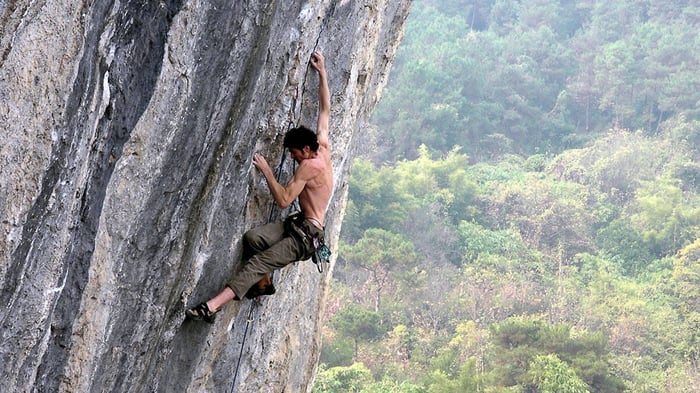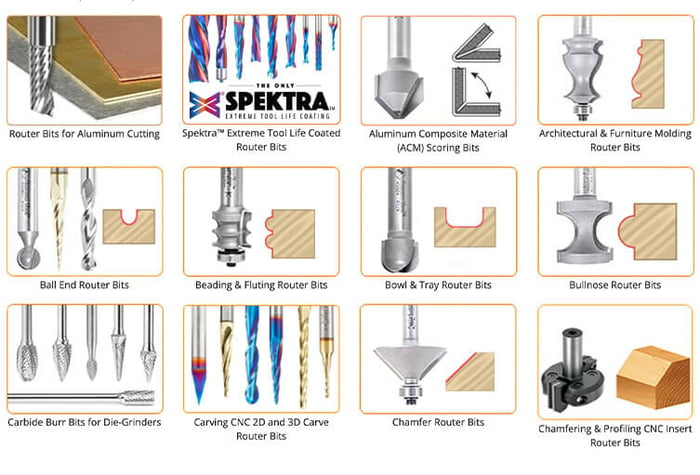
What is a Climb Cut? When Should I Use a Climb Cut?
When woodworking with a router, a "climb cut" is a cutting technique where the router bit rotates in the same direction as the movement of the router itself. This is in contrast to a conventional cut, where the router bit rotates against the direction of movement.
And the short answer is; if you have to ask what it is, don't use it!!

Here's a breakdown of the two cutting techniques:
Conventional Cut
In a conventional cut, the router bit rotates counterclockwise (when viewed from above) and you move the router from right to left, against the rotation of the bit.
This is the standard and safer way to use a router, especially when dealing with handheld routers. It allows for better control and reduces the risk of the router bit grabbing the wood and causing kickback.
Climb Cut
In this cutting method, the router bit still rotates counter-clockwise, but you move the router from left to right, in the same direction as the rotation of the bit.
This technique can be more aggressive and it is also riskier.
Climb cutting can be prone to causing tear-out, where the wood fibers are pulled up and can splinter, especially when starting the cut.
It can also be more challenging to control the router, as it may want to move faster and harder to steer. On a router table, it can lead to router bit kickback, where the bit just grabs the material out of your hands.
Due to these risks, climb cuts are generally not recommended for beginners or in situations where safety is a primary concern.
Hand-Held Routing Direction Diagram
 |
Conventional cuts always feed against the rotation of the bit.This can sometimes be confusing and the direction depends on whether you’re hand-held routing the perimeter of a workpiece, the interior of a workpiece, or using the router in a table. When hand-held routing the outer perimeter of a workpiece, such as the edge of a tabletop, push the router in a counter-clockwise direction. When hand-held routing the interior of a workpiece, such as an opening or cutout, push the router in a clockwise direction. When using a table mounted router, always push the stock from right to left. |
In summary, while a climb cut can be useful in certain situations for achieving a particular result, it should be used with caution, and experienced woodworkers typically employ it sparingly and with great care to minimize the risks associated with it.
Frequently Asked Questions
Do climb cuts create a smoother cut?
No. Moving the router in the same direction as the spinning router bit does not typically result in a smoother cut. In fact, it can often lead to a rougher surface finish and other issues.
A conventional cut, where you move the router against the rotation of the bit, is generally preferred for achieving a smoother cut. This is because it allows the cutting edges of the bit to engage the wood fibers cleanly, shearing them off as the bit rotates. The pressure is applied in a way that helps prevent tear-out and results in a cleaner, more controlled cut.
A climb cut, on the other hand, can cause problems such as tear-out, splintering, and a lack of control because the cutting edges of the bit can push the wood fibers ahead of them rather than cleanly cutting through them. This can result in a rough and less precise cut, which is why this method is generally avoided in situations where a smooth finish and precise cuts are desired.
So, to clarify, in woodworking with a router, moving the router against the direction of the spinning router bit (conventional cut) is the preferred method for achieving a smoother and cleaner cut.
Are there situations when an experienced carpenter might prefer to use a climb cut?
Yes, there are situations where an experienced woodworker might choose to do so, despite the inherent risks and challenges associated with it. While climb cuts are generally avoided for safety and quality reasons, there are a few scenarios where they may be employed:
- Grain Reversal: When routing across wood with changing grain direction, climb cutting can help reduce tear-out. By carefully entering the cut with a climb cut and then transitioning to a conventional cut, you can minimize tear-out where the grain direction changes abruptly.
- Preventing Tear-Out on the Exit Side: Sometimes, when routing near the edge of a workpiece, you may want to use a climb cut on the exit side of the cut to prevent tear-out. This is done by moving the router in the same direction as the bit's rotation as you exit the cut.
- Finish Passes: After making most of the material removal with conventional cuts, some woodworkers use a climb for a very light finish pass. This can sometimes help achieve a smoother surface, although it requires a steady hand and careful control of the router.
- Routing Difficult Woods: Some highly figured or problematic woods may benefit from climb cutting when other methods have failed to produce a satisfactory result. This should be done with caution and only by experienced woodworkers who are aware of the risks involved.
It's important to note that even in these situations, climb cuts require a high level of skill and control. The woodworker must be aware of the potential risks, such as loss of control, kickback, and tear-out, and take appropriate safety precautions.
Additionally, the choice to use a climb cut should be based on the specific characteristics of the wood being worked and the woodworking task at hand. Beginners and inexperienced woodworkers should generally avoid this method until they have gained sufficient experience and confidence in their router skills.
What about making a channel or dado - won't one side of the router inevitably be moving in the same direction as the router bit?
When using a plunge router bit to create a channel in wood, where the bit is cutting on both sides simultaneously, one side of the bit is technically performing a climb cut while the other side is making a conventional cut. In such a scenario, it's important to consider the dynamics of the cut.
The climb-cut side can be more prone to tear-out and splintering, especially at the beginning of the cut. You should exercise caution when starting the cut, as tear-out can be more likely to occur on that side.
The conventional cut side should generally provide better control and a cleaner finish.
What about a CNC router? Can it perform climb-cuts successfully?
When using a CNC router machine, the approach to climb cuts can differ from handheld routing. CNC routers are highly precise and capable of executing controlled climb cuts when properly programmed. However, there are still considerations:
CNC routers can be programmed to control the depth, speed, and other parameters of the cut, making it safer and more controlled than a handheld router.
CNC software can be used to generate toolpaths that minimize the risk of tear-out during climb cuts.
Even with CNC routers, it's essential to have a good understanding of the material being cut, tooling, and machine settings to ensure safe and effective climb cuts.
CNC machines can be used to perform climb cuts in a controlled and repeatable manner, but operators should be experienced and knowledgeable to set up the machine correctly.
In summary, CNC routers offer more control and precision when it comes to climb cuts compared to handheld routers. However, the operator's skill and knowledge in programming and operating the CNC machine remain critical to achieving safe and high-quality results. Always exercise caution and follow best practices when using any woodworking equipment, whether handheld or CNC.





